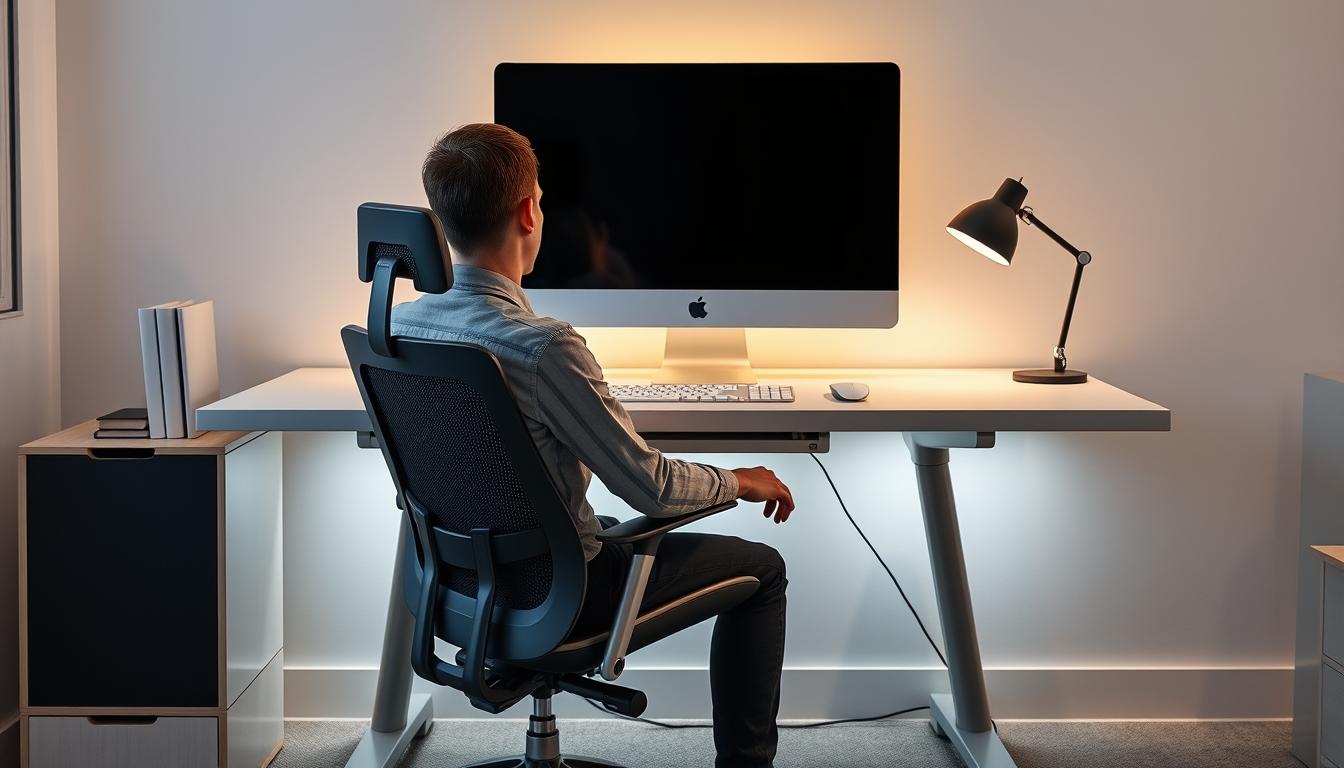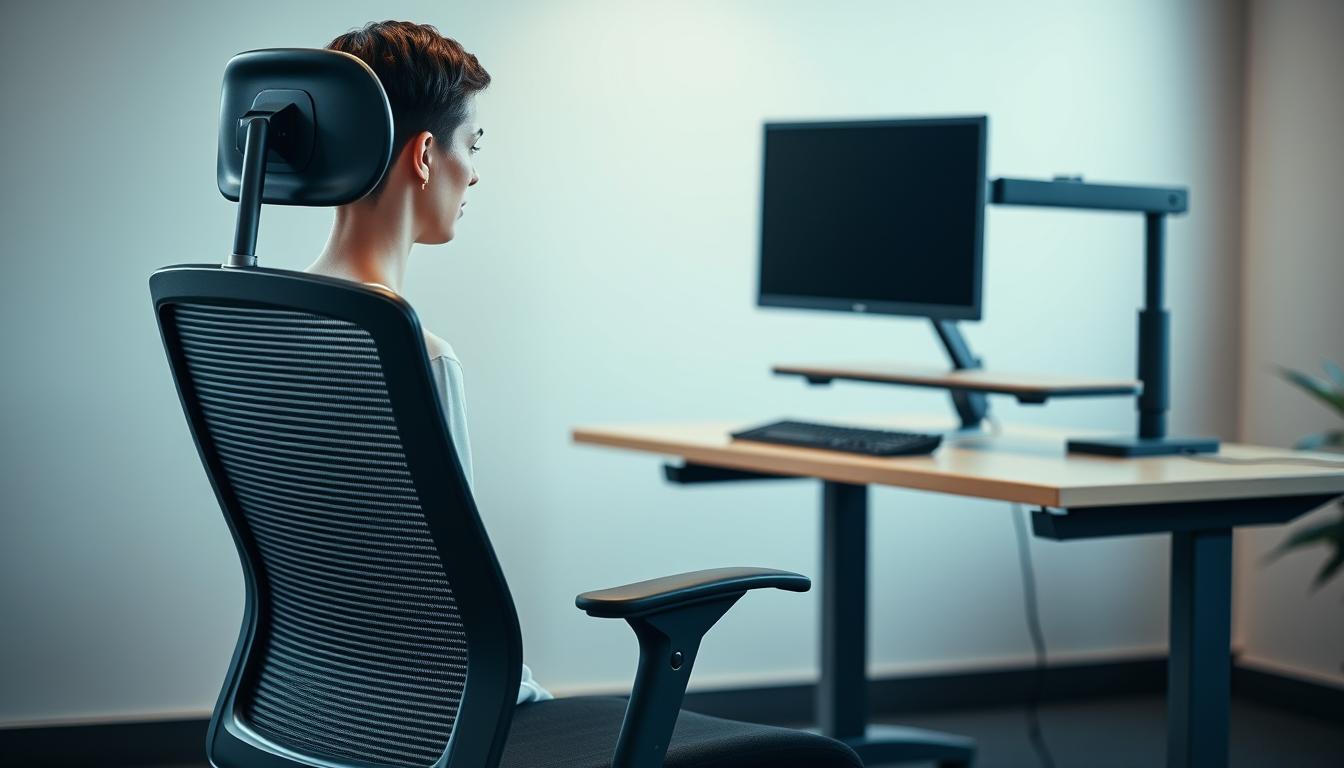Today, lots of people get neck pain from typing on keyboards. Most Americans sit in front of screens for about seven hours every day. This can lead to a lot of discomfort.
Finding out how sitting at your computer can cause neck pain is key. Anyone who wants to avoid tech neck needs to know this. This piece will tell you why it happens and how to make your workspace better. You’ll learn to work comfortably without sacrificing your productivity.
Understanding Tech Neck and Its Causes
Tech neck, also known as “text neck,” results from overusing digital devices. This overuse strains the neck and upper back. Looking down at screens for a long time makes this worse.
What is Tech Neck?
Tech neck happens when people use their phones, tablets, and computers too much. The problem starts when you tilt your head forward, putting pressure on your spine. Sitting badly, like slouching at a desk, makes it even more painful. Knowing how to sit right while using tech can ease the pain.
How Prolonged Screen Time Affects Your Neck
Too much screen time makes your neck stiff and sore. Sitting wrong and looking down strains your neck muscles, leading to ache. If you don’t fix this, it can turn into ongoing pain and less neck movement. Many people suffer from these issues without linking them to their technology use.
Recognizing Symptoms of Neck Strain
It’s very important to know the symptoms of tech neck to keep your neck healthy. Spotting the early signs can help avoid worse problems and make you feel better. Many suffer from pain after too much time on screens, leading to discomfort and other issues.
Common Symptoms of Tech Neck
Those with tech neck often face many symptoms that badly affect their day-to-day lives. These include:
- Stiffness in the neck
- Pain between the shoulder blades
- Frequent headaches
- Reduced range of motion in the neck
- Fatigue in neck muscles
When neck muscles work hard to keep the head up, it can make you very tired. If your neck hurts, you should pay attention to these symptoms and get help.
Long-term Consequences of Ignoring Pain
Not dealing with neck strain can lead to big problems later. Issues like ongoing neck pain and less movement can happen. Ignoring it might cause worse problems, like your spine not being aligned right or discs in your back getting damaged. If you don’t take care of it, you might need serious treatments or even surgery. It’s very important to look after your neck by knowing about it and doing things to prevent problems.
How to Avoid Neck Strain From Keyboard Typing
To keep your neck from hurting, start by adjusting your setup and how you sit. Making your screen and seating position better can really help your neck.
Adjusting Screen Height for Optimal Viewing
For comfy typing, the height of your screen matters a lot. If your screen is right at eye level, you won’t lean over as much. You can use stands or even books to lift your monitor up. Doing this helps your neck stay straight and not bend forward too much.
Maintaining Proper Posture While Typing
How you sit when you type is key to keeping your neck feeling good. Try to sit up with relaxed shoulders, your chin in, and your ears above your shoulders. Use your core muscles too, as they help keep your spine’s curve. These steps will make typing less of a pain and help keep your neck safe.
Ergonomic Workstation Setup
A well-planned ergonomic workstation boosts comfort and productivity. It also lowers the chance of strain from long work hours. Adjustments in chair height and where keyboards and mice go can help. The right setup keeps your body in a natural pose, easing possible discomfort.
Choosing the Right Chair and Desk Height
Pick a chair that keeps your spine well-supported, focusing on lumbar support to ease back strain. Your chair should be high enough so your feet stay flat on the ground. This keeps your knees at a 90-degree angle, helping with circulation and comfort.
Keyboard and Mouse Placement for Comfort
Putting your keyboard in the right spot is key to reducing neck and shoulder strain. Your keyboard should be placed in a way that your arms are at a 90-degree angle. Your wrists should stay straight while typing. The mouse should be near the keyboard to avoid overreaching and to keep your posture relaxed.
Importance of Taking Breaks
Taking regular breaks is key for keeping your neck healthy. Breaks not only help avoid pain but also make you more productive. Every 30 to 60 minutes, make sure to stand up, stretch, and move around. This helps ease muscle stiffness and boosts blood flow, which is vital for neck health.
Why Regular Movement Is Essential
Moving around during the day lowers the risk of neck problems. Whether it’s a short walk or just changing your position, all movement is good. Keeping active helps your neck muscles stay flexible and strong, preventing pain from staying in one spot too long.
Stretching Techniques to Relieve Tension
Neck stretches can really help ease tension from the day. Doing gentle head turns and shoulder rolls can make your neck move more easily. Try to do these stretches often each day to keep your neck feeling good. Making stretching a daily habit leads to a better work day.
Incorporating Strengthening Exercises
Strengthening exercises are key to boosting neck strength and making your posture better. By doing these exercises, you can fight the bad effects of too much screen time, like tech neck. Let’s look at some good exercises to strengthen your neck and upper back muscles. They can lead to improved posture and less discomfort.
Neck and Upper Back Strengthening Exercises
By adding exercises that focus on the neck and upper back, you can really make your neck stronger. Here are some exercises that work well:
- Chin Tucks: Gently tuck your chin towards your neck, hold it for a few seconds, and then do it again.
- Shoulder Blade Squeezes: Pull your shoulder blades towards each other and downwards, hold this pose, and then let go.
- Neck Extensions: Keep your body straight, and slowly tilt your head backwards, looking up at the ceiling.
Simple Exercises to Improve Posture
Simple exercises can greatly improve your posture. Doing these regularly can help get rid of the forward slump that comes from looking at screens too much:
- Wall Angels: Stand with your back to a wall, and slowly lift your arms in a “Y” shape, making sure they touch the wall.
- Pectoral Stretch: Stand in a doorway and place your arms on both sides, then gently lean forward to stretch the front of your body.
- Cat-Cow Stretch: On your hands and knees, move your back up and down to better your spine’s flexibility.

Utilizing Technology for Better Posture
In our digital world, technology helps us keep good posture and avoid neck pain. Posture apps and tools are now easy to use, making it simpler to take care of our body at work and home. Using these tech solutions can make a big difference in how we sit and stand.
Apps and Tools to Monitor Posture
Many posture apps remind us to check our body’s position during the day. They suggest when to straighten up while sitting or standing. With tools like Upright GO or Posture Reminder, fitting these tips into our day is easy, helping us look after our neck better.
Standing Desks and Their Benefits
Standing desks are a great option for better workspace ergonomics. They let us move between sitting and standing, which is good for our posture and lowers strain risks. By adding standing desks to our daily lives, we can work more comfortably and lower the chance of neck pain.
Lifestyle Changes to Support Neck Health
Making small changes in your life can really improve your neck’s health. It helps lessen the daily strain on your neck. Doing so brings lasting benefits for your overall health.
Daily Activities to Reduce Strain
Adding simple steps to your daily routine can decrease neck strain. Here are good ways to do it:
- Avoid cradling your phone between your ear and shoulder while talking.
- Use a headset or speakerphone to keep your neck aligned.
- Carry lighter bags to ease the pressure on your neck and shoulders.
Incorporating Aerobic Exercise for Muscle Health
Regular aerobic exercise does wonders for your muscles and neck. It boosts blood flow, improving neck health. Examples include brisk walking or swimming for 20-30 minutes, a few times a week. This kind of exercise eases neck tension.
Conclusion
To avoid neck strain while typing, it’s key to use ergonomic practices. Be mindful of your posture all day. Adjust your workstation for comfort, like making sure the screen is at your eye level. Also, ensure your chair supports your back well.
Move around often and stretch to keep neck pain at bay. Strengthen your neck and upper back with specific exercises. This will help you keep good posture when working.
By focusing on these tips, you’ll lower your chance of getting tech neck. More than that, your overall health will benefit. Keeping your neck healthy means you can work better without pain.



